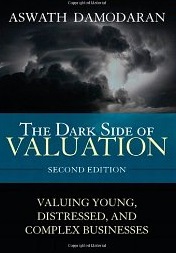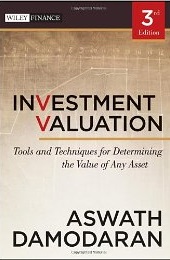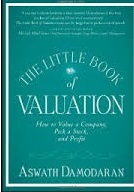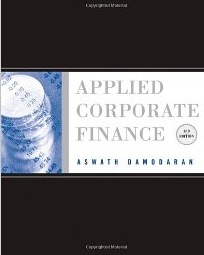GraduateTutor.com provides live tutoring for Professor Aswath Damodaran’s Corporate Finance and Valuation Classes at NYU’s Stern
School of Business as well as for finance students using his corporate finance, valuation and portfolio management books including Corporate Finance, Damodaran on Valuation, Investment Valuation, Applied Corporate Finance, The Dark Side of Valuation, Investment Management and Applied Corporate Finance.
Professor Aswath Damodaran is the Kerschner Family Chair in Finance Education and Professor of Finance at the Stern School of Business at New York University’s Stern School of Business. Professor Aswath Damodaran is truly an outstanding professor as evidenced by the number of teaching awards he has received (Earl Cheit Outstanding Teaching Award in 1985, Stern School of Business Excellence in Teaching Award in 1988, 1991, 1992, 1999, 2001, 2007 and 2008 and the NYU University-wide Distinguished Teaching Award in 1990).
Professor Aswath Damodaran’s Generosity
What we most admire about Professor Damodaran is his generosity in sharing his knowledge freely with finance students and finance professionals around the world. Professor Damodaran’s Stern School of Business website has a wealth of corporate finance data and information. In his mission statement he says
“Everything that I learn, do or write in the field of finance will be on this site sooner or later. I hope that you find the content useful and that you will share it with others”!
Professor Aswath Damodaran has generously provided access to his classes to students around the world via the internet. You can watch his classes on corporate finance, investing, valuation and portfolio management online as a webcast or on Youtube or iTunes. Here is a sample video on Youtube from symynd. Topics covered in this video include valuation bias, how much detail do we need, different approaches to valuation and more.
Remember there are more corporate finance, investing, valuation and portfolio management lessons from Professor Damodran online as webcasts or on Youtube or in iTunes .
He has provided plenty of corporate finance data for finance students free of cost on his NYU Stern School of Business website. We often direct students to his pages and here is some of the most useful content for finance students.
Primers on introductory topics required for finance students
- Accounting, statistics, present value, statistical distributions, risk aversion, corporate finance, valuation, investing or portfolio management.
Corporate finance data
- Annual Returns on Stock, T.Bonds and T.Bills: 1928 – Current (note the geometric and arithmetic averages at the bottom of the page)
- Equity risk premium (implied for the US market using the S&P 500) (market risk premium)
- Equity risk premium (for the non US markets)
- Betas for different industries (Levered and un-levered)
- Total Betas by Sector (for computing private company costs of equity)
- Marginal tax rates (from KPMG)
- Risk measures by category (beta, standard deviation, Hilo Risk Measure, etc)
- Cost of Capital, Cost of Equity, Cost of Debt by industry
- Jensen’s Alpha By Industry
- EVA and Equity EVA by Industry
- Operating and Net Margins by Industry Sector
- Earnings. Book Value and Sales Multiple Averages by Country
- Fundamental Growth Rate in EBIT by Industry
- Multiples by Market Cap Class (US)
- Value/EBIT & Value/EBITDA Multiples by Industry Sector
- Price and Value to Sales Ratios and Margins by Industry Sector
- Price and Value to Book Ratios and ROE by Industry Sector
- PE Ratios, PEG Ratios and Expected Growth Rates by Industry Sector
Financial Data on Individual Companies
- While the above are industry related data, Professor Damodaran also has data on individual companies that you can download.
Spreadsheets and Valuation models
- Professor Damodaran has also provided a variety of corporate finance and valuation spreadsheet models for finance students to use as a starting point for their valuation models.
Professor Aswath Damodaran’s Background & Research Areas
Professor Aswath Damodaran’s areas of research are in valuations, real estate and information and prices. He has published numerous papers which can be accessed on his NYU Stern website here.
Professor Aswath Damodaran completed his Bachelors in Accounting at Madras University, India and his M.S. in Management at the Indian Institute of Management, Bangalore, India. He went on to do an M.B.A. in 1981 from the University of California, Los Angeles and then finished his Ph.D. in Finance in 1985 also from the University of California, Los Angeles. He has been with the Stern School of Business and New York University since 1986.
Professor Aswath Damodaran is an active blogger and tweeter. He shares his thoughts on current events in the world of finance and investing. We highly recommend that all our students follow him as it enables students to see how finance is applied in real life. Every finance student will do well to follow him on his blog and twitter.
Books of Aswath Damodaran that we provide tutoring in
Applied Corporate Finance
(reviewed by GK)
Applied Corporate Finance written by corporate finance expert, Professor Aswath Damodaran, and published by Wiley John & Sons,
Applied Corporate Finance poses three significant questions, which all businesses have to answer, and delivers the tools as well as analytical techniques required for answering these questions, while offering a user’s perspective to corporate finance. In the book’s first part titled ‘The Investment Decision’, Professor Damodaran explains how to assess the risk besides developing a risk profile for a business, and have the risk profile converted into a hurdle rate. Basic rules for estimating the returns on investments are also explained to the reader. The second part of the book categorized as ‘The Financing Decision’ deals with the question, “how should these investments be funded?”. Generally, companies can use debt, equity or certain combination of both for funding projects. This section of the book has the relationship between this option and the hurdle rate examined for analyzing projects. It also explains how to use the funding decision for maximizing company value. The third part of the book – ‘The Dividend Decision’ deals with the question “How much cash can be and needs to be returned to the owners?”. Here a process for deciding the volume of cash that should be siphoned off the business and the form in which it should be carried out, has been established. Applied Corporate Finance’s final section ties the value of the company to these three decisions, and delivers insight into how companies could boost value.
Contents of Applied Corporate Finance
- The Foundations
- The Objective in Decision Making
- Basics of Risk
- Risk Measurement and Hurdle Rates in Practice
- Measuring Return on Investments
- Project Interactions, Side Costs, and Side Benefits
- Capital Structure; Overview of the Financing Division
- Capital Structure; The Optimal Financial Mix
- Capital Structure; The financing Details
- Dividend Policy
- Analyzing Cash Returned to Stockholders
- Valuation; Principles and Practice
The Dark Side of Valuation: Valuing Young, Distressed, and Complex Businesses
(reviewed by GK)
The Dark Side of Valuation, a definitive guide to valuing companies that are hard to value in today’s environment. For long, financial
Presently, amidst the global economic crisis that is widely felt, a considerably wider spectrum of enterprises as well as assets faces this challenge. These entities range from equities based in foreign countries to mortgage-based securities and financial services companies.
The Dark Side of Valuation by Professor Aswath Damodaran has in it a wide perspective to deem every company that tends to resist easy valuations a target to tackle. The whole corporate life-cycle ranging from idea and nascent growth firms to those that are in distress and decline, is covered by the author in the book. Professor Damodaran also offers in The Dark Side of Valuation, specific guidance for valuing human capital, technology, commodity and cyclical companies. Special emphasis has been placed by the author on the financial sector, highlighting the implications of the radically transforming credit markets of the present day for valuation. Along the way, Prof Damodaran also addresses in his book, questions based on valuation which have gained urgency all of a sudden. These questions range from “Are the treasuries of the US free of risks?” to “How are the assets valued in highly illiquid markets?”
Contents of the book – The Dark Side of Valuation: Valuing Young, Distressed, and Complex Businesses
- The Dark Side of Valuation
- Intrinsic Valuation
- Probabilistic Valuation; Scenario Analysis, Decision Trees and Simulations
- Relative Valuation
- Real Options Valuation
- A Shaky Base; A ‘Risky’ Risk-Free Rate
- Risky Ventures; Assessing the Price of Risk
- Micro Matters; The Real Economy
- Baby Steps; Young and Start-Up Companies
- Shooting Stars? Growth Companies
- The Grown Ups; Mature Companies
- Winding Down; Declining Companies
- Ups and Downs; Cyclical and Commodity Companies
- Mark to Market; Financial Services Companies
- Invisible Investments; Firms with Intangible Assets
- Volatility Rules; Emerging-Market Companies
- The Octopus; Multibusiness Global Companies
- Going Over to the Light; Vanquishing the Dark Side
Investment Valuation: Tools and Techniques for Determining the Value of Any Asset
(reviewed by GK)
Investment Valuation: Tools and Techniques for Determining the Value of Any Asset is a book that highlights tools and techniques
Through Investment Valuation: Tools and Techniques for Determining the Value of Any Asset, Prof Damodaran returns with a comprehensively revised second edition of his much popular Investment Valuation. This complete guide covers a broad range of tools and techniques, old as well as new, for having the value of an asset, including the valuation of bonds, real assets, stock, futures, options and more. The Investment Valuation book addresses fresh sectors such as private and financial service companies, and dot-coms which pose complex valuation issues, using updated real world models as well as the most advanced valuation tools. Prof Damodaran also guides the reader through the theory as well as application of various models of valuation besides clarifying the whole process ranging from relative valuation and valuation of cash flow to acquisition valuation.
Contents of the Book – Investment Valuation: Tools and Techniques for Determining the Value of Any Asset
- Introduction to Valuation
- Approaches to Valuation
- Understanding Financial Statements
- The Basics of Risk
- Option Pricing Theory and Models
- Market Efficiency
- Riskless Rates and Risk Premiums
- Estimating Risk Parameters and Costs of Financing
- Measuring Earnings
- From Earnings to Cash Flows
- Estimating Growth
- Closure in Valuation; Estimating Terminal Value
- Dividend Discount Models
- Free Cash Flow to Equity Discount Models
- Firm Valuation; Cost of Capital and Adjusted Present Value Approaches
- Estimating Equity Value per Share
- Fundamental Principles of Relative Valuation
- Earnings Multiples
- Book Value Multiples
- Revenue Multiples and Sector Specific Multiples
- Valuing Financial Service Firms
- Valuing Firms with Negative Earnings
- Valuing Young or Start-up Firms
- Valuing Private Firms
- Acquisitions and Takeovers
- Valuing Real Estate
- Valuing Other Assets
- The Option to Delay and Valuation Implications
- The Options to Expand and to Abandon; Valuation Implications
- Valuing Equity in Distressed Firms
- Value Enhancement: A Discounted Cash Flow Valuation Framework
- Value Enhancement; Economic Value Added, Cash Flow Return on Investment, and Other Tools
- Valuing Bonds
- Valuing Futures and Forward Contracts
- Overview and Conclusion
The Little Book of Valuation: How to Value a Company, Pick a Stock and Profit
(reviewed by GK)
The Little Book of Valuation is a highly accessible and intuitive guide to stock valuation written by Professor Aswath Damodaran. 
The fundamentals of valuation have been instilled by Professor Damodaran, page by page, without overlooking or glossing over key concepts. The models are developed in the book in a way that the reader can digest and use them with ease. Professor Damodaran also covers different approaches of valuation ranging from discounted or intrinsic cash flow valuation and relative or multiple valuations to real options based valuation. The book includes case studies as well as examples, which will help the investor help boost his valuation skills. Professor Damodaran has written The Little Book of Valuation with the individual investor in mind. The Little Book of Valuation not just helps in valuing a company quickly, but also helps one make sense of valuations carried out by others or found in reports of equity researchers.
Contents of The Little Book of Valuation
Introduction: Hit the Ground Running – Valuation Basics
- Value – More Than a Number
- Power Tools of the Trade
- Every Asset Has an Intrinsic Value
- It’s All Relative!
From Cradle to Grave –Life Cycle and Valuation
- Promise Aplenty
- Growing Pains
- Valuation Viagra
- Doomsday
Special Situations in Valuation
- Bank on It
- Roller-Coaster Investing
- Invisible Value
- Conclusion: Rules for the Road
Email us at care@graduatetutor.com or call us or simply fill out the sign up form below to start live one-on-one finance tutoring using any of Professor Aswath Damodaran’s corporate finance, valuation, investing or portfolio management books including Corporate Finance, Damodaran on Valuation, Investment Valuation, Applied Corporate Finance, The Dark Side of Valuation, Investment Management and Applied Corporate Finance.

